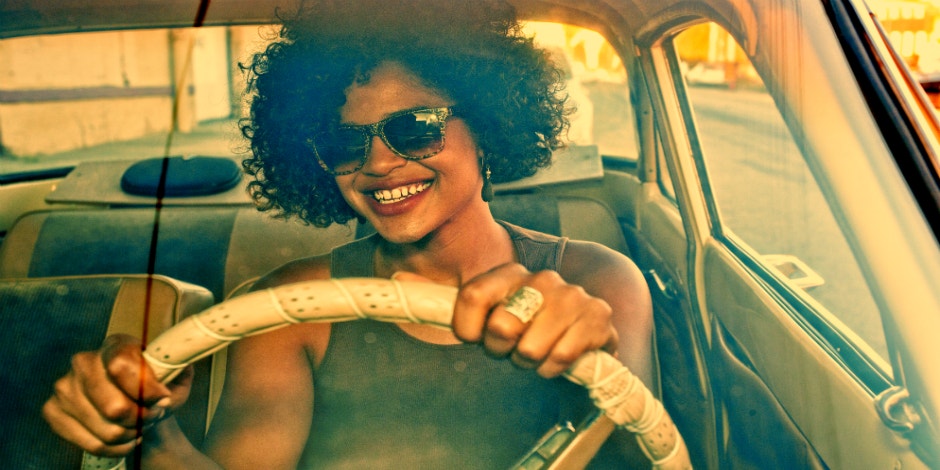10 Life-Enhancing Things You Can Do While Sitting At A Red Light
Or while you're in an Uber.
 getty
getty Stoplights and traffic can be stressful and frustrating. Estimates of the amount of time we spend at stoplights or barely moving in traffic range from about 20 minutes per day to two work-weeks per year. And much of that time we’re in the car all by our lonesomes.
Why not use the time to do something that will improve your life instead of eating away at it? Here are my top ten ways to find happiness:
1. Breathe.
I teach my clients a breathing technique that I use often myself as an antidote to stress, anxiety, and anger. It is a direct biological antidote to stress, improves emotional resilience, boosts immune function, and sitting in the car is a great time to do it. Just slowing and deepening your breath (imagine breathing into your belly) is a good start. If then you lengthen your out breath, say to a count of six or so, that’s even better. Keep that up for five minutes or more — you’ll feel the results immediately, and the benefits last for hours.
2. Gratitude list.
This is another great thing to do anytime, but in the car, it’s a no-brainer. Gratitude is another antidote to worry and irritation, and the more you practice the better it gets. Just think of one or more things that you’re grateful for. That’s it! (Though for extra credit, maintain a feeling of gratitude during the breathing and you’ll supercharge the goodness.)
3. Savor the good.
Thanks to Rick Hanson for this one. You can read about it in detail in his books, or online, but basically, it’s a variation of gratitude, and a way to get even more juice out of your gratitude practice. Think about something good that happened to you recently or something you appreciate and just dwell on those good feelings for 20 seconds. You’re rewiring your brain towards enjoyment.
4. Kegels.
Seriously. They’re good for guys too. Look it up. ‘Nuff said.
5. Drop in.
Help yourself to a minute of mindfulness. Just let go of any thoughts and tune in to your senses. Hear all the sounds around you (even the annoying ones — see if you can just hear without judgment), notice the smells, feel how your car seat supports your body, notice and let go of little tensions, take in the color of the sky. Be present.
6. Nostalgize.
(Bet you didn’t even know that was a word!) If you’ve filled up on the present, check out the past. Turns out that for many people nostalgizing can relieve melancholy and help us feel more connected (for more on the science and who the exceptions are, see this New York Times article. Again, don’t get too lost in your memories while you’re driving!
7. Stretch out.
Do this one safely — you are in the car after all! — but at a full stop at a light, you can gently stretch your feet and ankles, your arms and hands, shift your pelvis, your back, and your neck. Picture a dog or cat stretching luxuriously and enjoy the pleasure of those small movements.
8. Tune in.
OK, a lot of us do this anyway in the car, but be more intentional about it. Play something you really want to hear at the moment, and focus on the parts you love. Or use an old song as a pathway to nostalgia (see the nostalgia article above). This is a special form of dropping in.
9. Wish someone happiness.
The great thing about this one is there are so many people to choose from! It could be someone in your life that you care for, someone who’s suffering, or even the drivers or pedestrians around you. It’s a great way to offset judgments — for instance, road rage. Wish that person happiness and see how much healthier that feels.
10. Work on your relationship.
(You knew I had to get this in here somewhere!) Devote some thought to things you could do to improve your relationship or make your partner happy. There’s a huge range of possibilities here, from sending a loving text (pull over if you’re driving!), to planning something special, to thinking about the specific ways your partner feels love and appreciation and committing to doing some of those things for him or her.
Pick one of these that appeals to you and try it at as many stoplights as you can for three days. Then try another one for three days. Pretty soon stoplights (and traffic) — instead of frustrations — will become cues for life-enhancement.
Dr. Robert Solley is a psychologist specializing in couples and adult individual therapy in San Francisco. He is an associate at the Couples Institute in Menlo Park, CA, teaches a graduate couples therapy class at the University of San Francisco, and writes on Medium.

